Forecasting Health Service Need: Gastrointestinal Disease Costs
VerifiedAdded on 2022/10/08
|16
|3869
|16
Report
AI Summary
This report addresses the critical issue of forecasting health service needs, specifically focusing on the expenditure related to gastrointestinal diseases in individuals aged 65 and older. The analysis begins by highlighting the growing concern of financial burdens associated with these conditions, emphasizing the impact of aging on the digestive system and the financial constraints faced by older adults, particularly in Australia. The report delves into the impacts of gastrointestinal diseases, including the reduced access to healthcare due to cost, the potential for increased mortality rates, and the broader societal implications. It further explores the risks of ramifications, illustrating the escalating expenditure trends through graphical representations and predicting potential increases in costs if the issue remains unaddressed. The report presents two scenario models to forecast future expenditure, offering insights into the potential financial strain on the healthcare system. Finally, it proposes recommendations aimed at mitigating the financial burden and improving healthcare access for older adults suffering from gastrointestinal disorders.
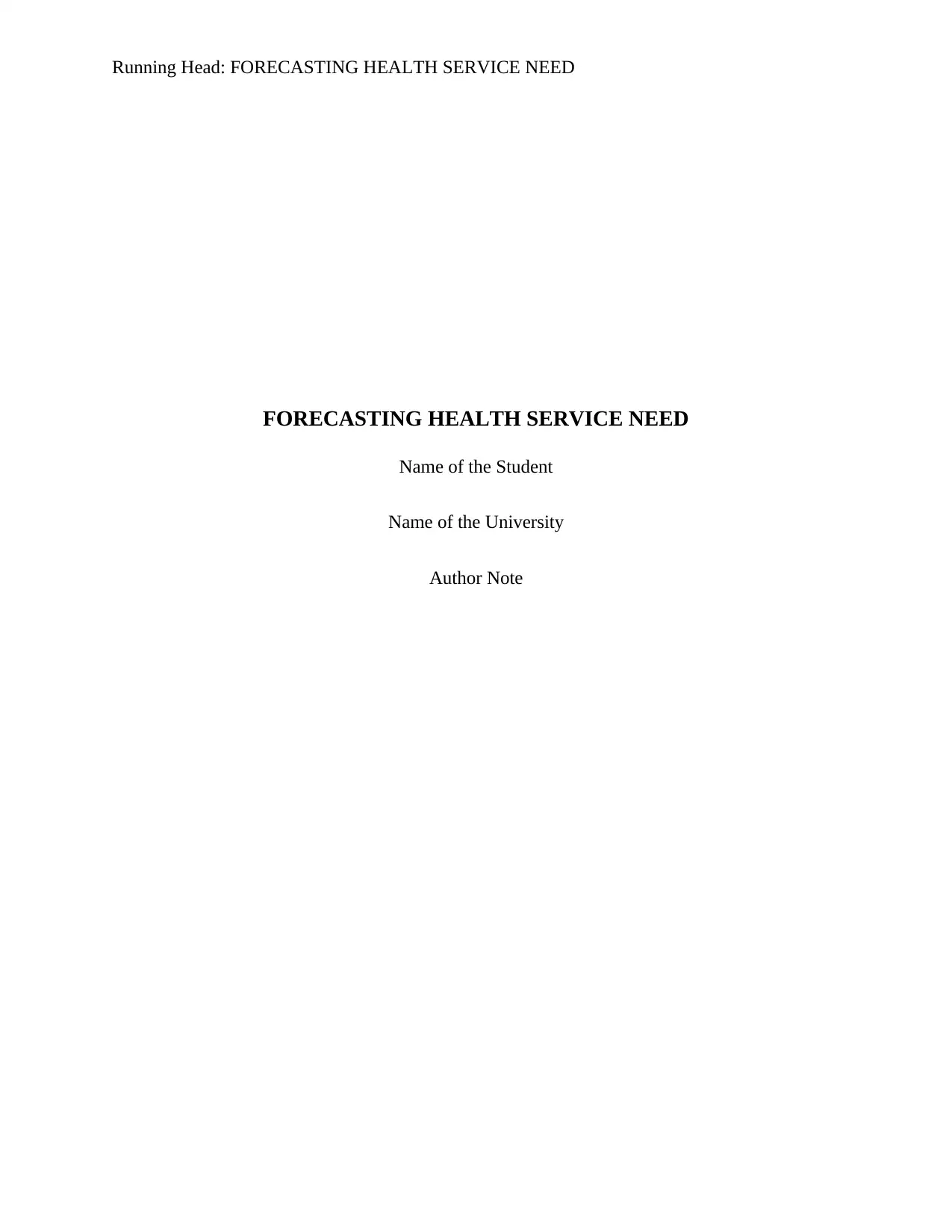
Running Head: FORECASTING HEALTH SERVICE NEED
FORECASTING HEALTH SERVICE NEED
Name of the Student
Name of the University
Author Note
FORECASTING HEALTH SERVICE NEED
Name of the Student
Name of the University
Author Note
Paraphrase This Document
Need a fresh take? Get an instant paraphrase of this document with our AI Paraphraser

1Running Head: FORECASTING HEALTH SERVICE NEED
Table of Contents
ISSUE:.............................................................................................................................................2
DISCUSSION:.................................................................................................................................3
The situation of the issue becoming a matter of concern:...........................................................3
Impacts related to the issue:.........................................................................................................4
Risk of Ramifications:.................................................................................................................7
Scenario Models:.........................................................................................................................8
Recommendations:....................................................................................................................12
References:....................................................................................................................................14
Table of Contents
ISSUE:.............................................................................................................................................2
DISCUSSION:.................................................................................................................................3
The situation of the issue becoming a matter of concern:...........................................................3
Impacts related to the issue:.........................................................................................................4
Risk of Ramifications:.................................................................................................................7
Scenario Models:.........................................................................................................................8
Recommendations:....................................................................................................................12
References:....................................................................................................................................14
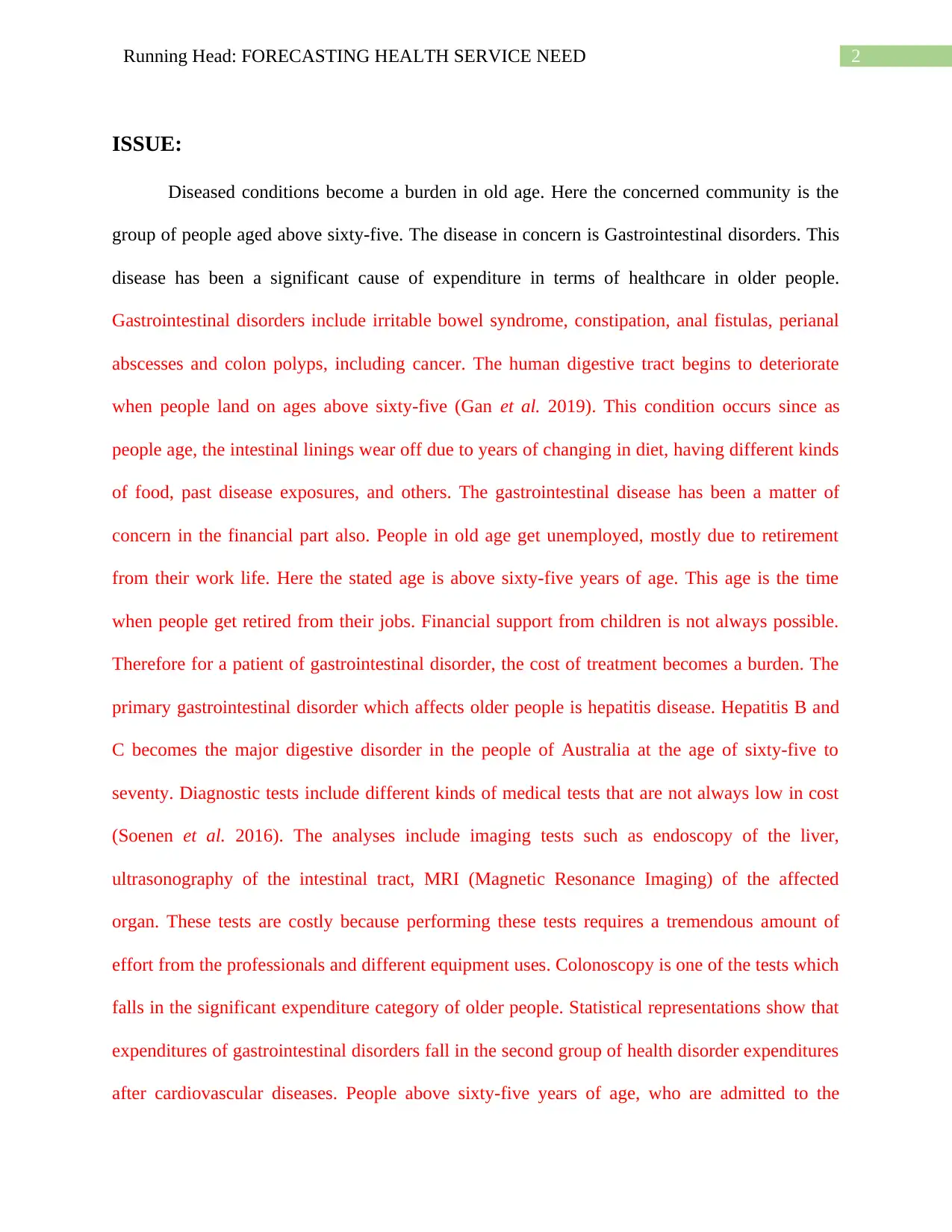
2Running Head: FORECASTING HEALTH SERVICE NEED
ISSUE:
Diseased conditions become a burden in old age. Here the concerned community is the
group of people aged above sixty-five. The disease in concern is Gastrointestinal disorders. This
disease has been a significant cause of expenditure in terms of healthcare in older people.
Gastrointestinal disorders include irritable bowel syndrome, constipation, anal fistulas, perianal
abscesses and colon polyps, including cancer. The human digestive tract begins to deteriorate
when people land on ages above sixty-five (Gan et al. 2019). This condition occurs since as
people age, the intestinal linings wear off due to years of changing in diet, having different kinds
of food, past disease exposures, and others. The gastrointestinal disease has been a matter of
concern in the financial part also. People in old age get unemployed, mostly due to retirement
from their work life. Here the stated age is above sixty-five years of age. This age is the time
when people get retired from their jobs. Financial support from children is not always possible.
Therefore for a patient of gastrointestinal disorder, the cost of treatment becomes a burden. The
primary gastrointestinal disorder which affects older people is hepatitis disease. Hepatitis B and
C becomes the major digestive disorder in the people of Australia at the age of sixty-five to
seventy. Diagnostic tests include different kinds of medical tests that are not always low in cost
(Soenen et al. 2016). The analyses include imaging tests such as endoscopy of the liver,
ultrasonography of the intestinal tract, MRI (Magnetic Resonance Imaging) of the affected
organ. These tests are costly because performing these tests requires a tremendous amount of
effort from the professionals and different equipment uses. Colonoscopy is one of the tests which
falls in the significant expenditure category of older people. Statistical representations show that
expenditures of gastrointestinal disorders fall in the second group of health disorder expenditures
after cardiovascular diseases. People above sixty-five years of age, who are admitted to the
ISSUE:
Diseased conditions become a burden in old age. Here the concerned community is the
group of people aged above sixty-five. The disease in concern is Gastrointestinal disorders. This
disease has been a significant cause of expenditure in terms of healthcare in older people.
Gastrointestinal disorders include irritable bowel syndrome, constipation, anal fistulas, perianal
abscesses and colon polyps, including cancer. The human digestive tract begins to deteriorate
when people land on ages above sixty-five (Gan et al. 2019). This condition occurs since as
people age, the intestinal linings wear off due to years of changing in diet, having different kinds
of food, past disease exposures, and others. The gastrointestinal disease has been a matter of
concern in the financial part also. People in old age get unemployed, mostly due to retirement
from their work life. Here the stated age is above sixty-five years of age. This age is the time
when people get retired from their jobs. Financial support from children is not always possible.
Therefore for a patient of gastrointestinal disorder, the cost of treatment becomes a burden. The
primary gastrointestinal disorder which affects older people is hepatitis disease. Hepatitis B and
C becomes the major digestive disorder in the people of Australia at the age of sixty-five to
seventy. Diagnostic tests include different kinds of medical tests that are not always low in cost
(Soenen et al. 2016). The analyses include imaging tests such as endoscopy of the liver,
ultrasonography of the intestinal tract, MRI (Magnetic Resonance Imaging) of the affected
organ. These tests are costly because performing these tests requires a tremendous amount of
effort from the professionals and different equipment uses. Colonoscopy is one of the tests which
falls in the significant expenditure category of older people. Statistical representations show that
expenditures of gastrointestinal disorders fall in the second group of health disorder expenditures
after cardiovascular diseases. People above sixty-five years of age, who are admitted to the
⊘ This is a preview!⊘
Do you want full access?
Subscribe today to unlock all pages.

Trusted by 1+ million students worldwide
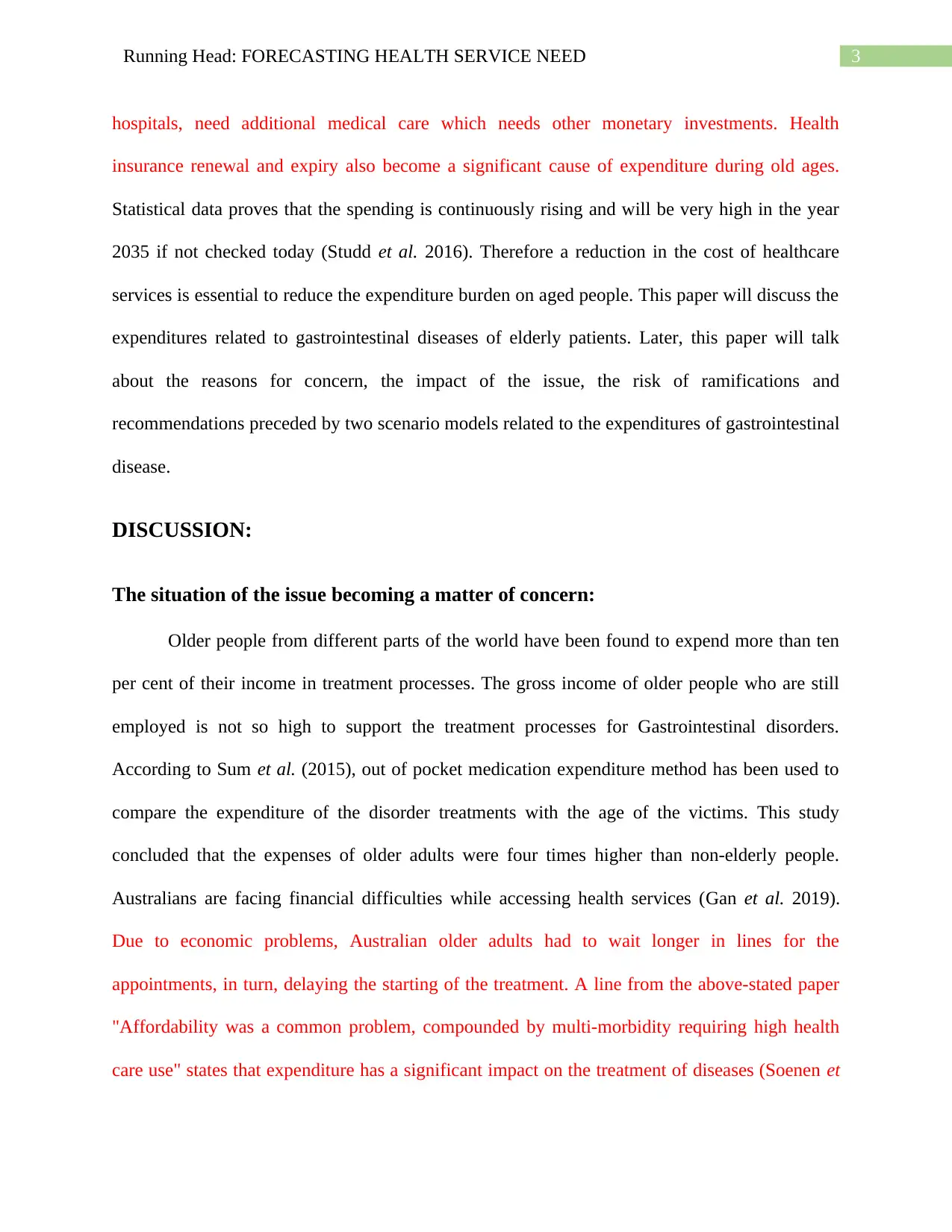
3Running Head: FORECASTING HEALTH SERVICE NEED
hospitals, need additional medical care which needs other monetary investments. Health
insurance renewal and expiry also become a significant cause of expenditure during old ages.
Statistical data proves that the spending is continuously rising and will be very high in the year
2035 if not checked today (Studd et al. 2016). Therefore a reduction in the cost of healthcare
services is essential to reduce the expenditure burden on aged people. This paper will discuss the
expenditures related to gastrointestinal diseases of elderly patients. Later, this paper will talk
about the reasons for concern, the impact of the issue, the risk of ramifications and
recommendations preceded by two scenario models related to the expenditures of gastrointestinal
disease.
DISCUSSION:
The situation of the issue becoming a matter of concern:
Older people from different parts of the world have been found to expend more than ten
per cent of their income in treatment processes. The gross income of older people who are still
employed is not so high to support the treatment processes for Gastrointestinal disorders.
According to Sum et al. (2015), out of pocket medication expenditure method has been used to
compare the expenditure of the disorder treatments with the age of the victims. This study
concluded that the expenses of older adults were four times higher than non-elderly people.
Australians are facing financial difficulties while accessing health services (Gan et al. 2019).
Due to economic problems, Australian older adults had to wait longer in lines for the
appointments, in turn, delaying the starting of the treatment. A line from the above-stated paper
"Affordability was a common problem, compounded by multi-morbidity requiring high health
care use" states that expenditure has a significant impact on the treatment of diseases (Soenen et
hospitals, need additional medical care which needs other monetary investments. Health
insurance renewal and expiry also become a significant cause of expenditure during old ages.
Statistical data proves that the spending is continuously rising and will be very high in the year
2035 if not checked today (Studd et al. 2016). Therefore a reduction in the cost of healthcare
services is essential to reduce the expenditure burden on aged people. This paper will discuss the
expenditures related to gastrointestinal diseases of elderly patients. Later, this paper will talk
about the reasons for concern, the impact of the issue, the risk of ramifications and
recommendations preceded by two scenario models related to the expenditures of gastrointestinal
disease.
DISCUSSION:
The situation of the issue becoming a matter of concern:
Older people from different parts of the world have been found to expend more than ten
per cent of their income in treatment processes. The gross income of older people who are still
employed is not so high to support the treatment processes for Gastrointestinal disorders.
According to Sum et al. (2015), out of pocket medication expenditure method has been used to
compare the expenditure of the disorder treatments with the age of the victims. This study
concluded that the expenses of older adults were four times higher than non-elderly people.
Australians are facing financial difficulties while accessing health services (Gan et al. 2019).
Due to economic problems, Australian older adults had to wait longer in lines for the
appointments, in turn, delaying the starting of the treatment. A line from the above-stated paper
"Affordability was a common problem, compounded by multi-morbidity requiring high health
care use" states that expenditure has a significant impact on the treatment of diseases (Soenen et
Paraphrase This Document
Need a fresh take? Get an instant paraphrase of this document with our AI Paraphraser
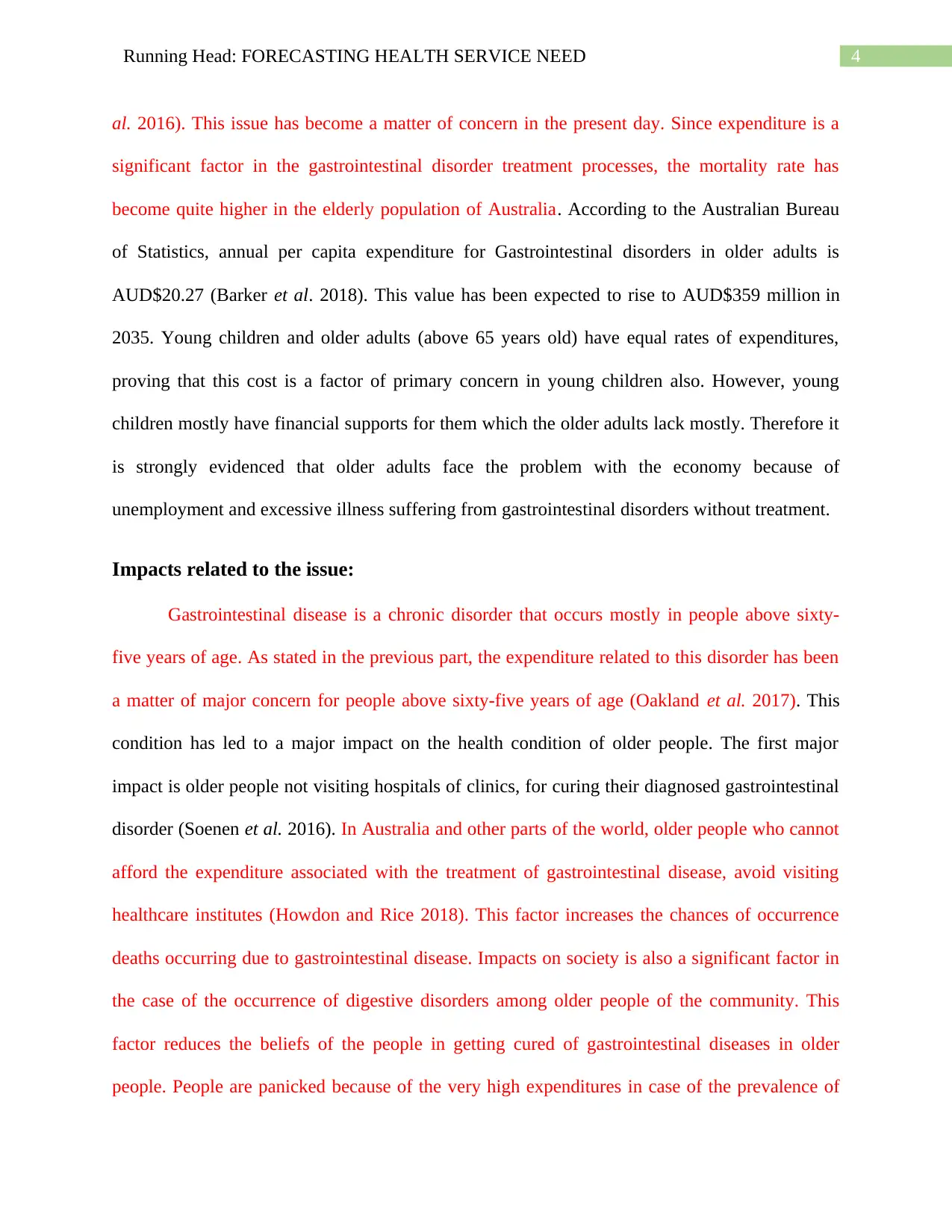
4Running Head: FORECASTING HEALTH SERVICE NEED
al. 2016). This issue has become a matter of concern in the present day. Since expenditure is a
significant factor in the gastrointestinal disorder treatment processes, the mortality rate has
become quite higher in the elderly population of Australia. According to the Australian Bureau
of Statistics, annual per capita expenditure for Gastrointestinal disorders in older adults is
AUD$20.27 (Barker et al. 2018). This value has been expected to rise to AUD$359 million in
2035. Young children and older adults (above 65 years old) have equal rates of expenditures,
proving that this cost is a factor of primary concern in young children also. However, young
children mostly have financial supports for them which the older adults lack mostly. Therefore it
is strongly evidenced that older adults face the problem with the economy because of
unemployment and excessive illness suffering from gastrointestinal disorders without treatment.
Impacts related to the issue:
Gastrointestinal disease is a chronic disorder that occurs mostly in people above sixty-
five years of age. As stated in the previous part, the expenditure related to this disorder has been
a matter of major concern for people above sixty-five years of age (Oakland et al. 2017). This
condition has led to a major impact on the health condition of older people. The first major
impact is older people not visiting hospitals of clinics, for curing their diagnosed gastrointestinal
disorder (Soenen et al. 2016). In Australia and other parts of the world, older people who cannot
afford the expenditure associated with the treatment of gastrointestinal disease, avoid visiting
healthcare institutes (Howdon and Rice 2018). This factor increases the chances of occurrence
deaths occurring due to gastrointestinal disease. Impacts on society is also a significant factor in
the case of the occurrence of digestive disorders among older people of the community. This
factor reduces the beliefs of the people in getting cured of gastrointestinal diseases in older
people. People are panicked because of the very high expenditures in case of the prevalence of
al. 2016). This issue has become a matter of concern in the present day. Since expenditure is a
significant factor in the gastrointestinal disorder treatment processes, the mortality rate has
become quite higher in the elderly population of Australia. According to the Australian Bureau
of Statistics, annual per capita expenditure for Gastrointestinal disorders in older adults is
AUD$20.27 (Barker et al. 2018). This value has been expected to rise to AUD$359 million in
2035. Young children and older adults (above 65 years old) have equal rates of expenditures,
proving that this cost is a factor of primary concern in young children also. However, young
children mostly have financial supports for them which the older adults lack mostly. Therefore it
is strongly evidenced that older adults face the problem with the economy because of
unemployment and excessive illness suffering from gastrointestinal disorders without treatment.
Impacts related to the issue:
Gastrointestinal disease is a chronic disorder that occurs mostly in people above sixty-
five years of age. As stated in the previous part, the expenditure related to this disorder has been
a matter of major concern for people above sixty-five years of age (Oakland et al. 2017). This
condition has led to a major impact on the health condition of older people. The first major
impact is older people not visiting hospitals of clinics, for curing their diagnosed gastrointestinal
disorder (Soenen et al. 2016). In Australia and other parts of the world, older people who cannot
afford the expenditure associated with the treatment of gastrointestinal disease, avoid visiting
healthcare institutes (Howdon and Rice 2018). This factor increases the chances of occurrence
deaths occurring due to gastrointestinal disease. Impacts on society is also a significant factor in
the case of the occurrence of digestive disorders among older people of the community. This
factor reduces the beliefs of the people in getting cured of gastrointestinal diseases in older
people. People are panicked because of the very high expenditures in case of the prevalence of

5Running Head: FORECASTING HEALTH SERVICE NEED
this disease among older people. This impact also affects young generations. This is because the
younger people had to force themselves to get a good job which will provide them with good
economic support. Another impact on older people is that they attempt self-harm activities after
not being able to cope up with the cost of treatment (López-Silva, Bañuls and Turoff 2015). The
diagnosis cost is also high for gastrointestinal diseases. Therefore, it becomes harder for the
middle class older people to carry forward the expenditure related to the disease. The avoidance
of hospital visits makes them prone to the diseased condition. People of ages sixty to seventy-
five are more prone to receiving a colonoscopy. Colonoscopy is a very costly treatment
procedure. Therefore, unemployed older people who have low economic support cannot afford
for the treatment process. According to the data collected, alcohol-addicted people have higher
cases of gastrointestinal problems in older ages. As a result, the impacted people are mainly
older people and the younger generations also. Evidence-based case studies prove that the
economic burden of gastrointestinal diseases has imposed a significant impact on older people.
According to Studd et al. (2016), the main financial burden in various states of Australia is
gastrointestinal disorders. Chemotherapy is also required for older patients. The cost of
chemotherapy is significantly high in the case of patients. This cost is described by following a
Patient Chemotherapy Visit Model (PCV), which states the standard rates for each chemotherapy
chair per day. The price is significantly higher for the retreatment processes and accounts for
25% higher than the standard cost. This condition makes people aged 65 years, and unemployed,
avoid chemotherapy for their disease. The above-stated factor, in turn, increases the chances of
complicacy in the disease. This condition causes not only causes gastrointestinal disorder to be
an economic burden but also creates opportunities for severe complications which becomes a
this disease among older people. This impact also affects young generations. This is because the
younger people had to force themselves to get a good job which will provide them with good
economic support. Another impact on older people is that they attempt self-harm activities after
not being able to cope up with the cost of treatment (López-Silva, Bañuls and Turoff 2015). The
diagnosis cost is also high for gastrointestinal diseases. Therefore, it becomes harder for the
middle class older people to carry forward the expenditure related to the disease. The avoidance
of hospital visits makes them prone to the diseased condition. People of ages sixty to seventy-
five are more prone to receiving a colonoscopy. Colonoscopy is a very costly treatment
procedure. Therefore, unemployed older people who have low economic support cannot afford
for the treatment process. According to the data collected, alcohol-addicted people have higher
cases of gastrointestinal problems in older ages. As a result, the impacted people are mainly
older people and the younger generations also. Evidence-based case studies prove that the
economic burden of gastrointestinal diseases has imposed a significant impact on older people.
According to Studd et al. (2016), the main financial burden in various states of Australia is
gastrointestinal disorders. Chemotherapy is also required for older patients. The cost of
chemotherapy is significantly high in the case of patients. This cost is described by following a
Patient Chemotherapy Visit Model (PCV), which states the standard rates for each chemotherapy
chair per day. The price is significantly higher for the retreatment processes and accounts for
25% higher than the standard cost. This condition makes people aged 65 years, and unemployed,
avoid chemotherapy for their disease. The above-stated factor, in turn, increases the chances of
complicacy in the disease. This condition causes not only causes gastrointestinal disorder to be
an economic burden but also creates opportunities for severe complications which becomes a
⊘ This is a preview!⊘
Do you want full access?
Subscribe today to unlock all pages.

Trusted by 1+ million students worldwide

6Running Head: FORECASTING HEALTH SERVICE NEED
financial problem too. Therefore it can be stated that digestive disorders have become an
economic burden for the older population of Australia.
financial problem too. Therefore it can be stated that digestive disorders have become an
economic burden for the older population of Australia.
Paraphrase This Document
Need a fresh take? Get an instant paraphrase of this document with our AI Paraphraser

7Running Head: FORECASTING HEALTH SERVICE NEED
Risk of Ramifications:
Figure 2 provides a graphical representation of the increase in the expenditure for
gastrointestinal disorder per year starting from 2004. This measurement has been done for four
years interval and is measure up to 2035. The different bar lines for the respective years present
in the bar lines, which is increasing per year gaps. X-axis shows the year range (2004, 2008,
2012, 2016, 2020, 2024, 2028, 2032, 2035). Y-axis shows the expenditure rates per year. The
graph shows that the expenditure rate is increasing by 500 every year. This rate of increase is
very high, and this is evident from the increasing peaks of the bar graph. These peaks show the
highest calculated expenditure rate in the year concerned. Resolving this issue will reduce the
expenditure rate very reduce to affordable values so that older people can avail of the treatment
plans. The peaks of this bar graph for each year gap will also be parallel to each other, proving
that the expenditure rate is following an average value. However, if this issue is not resolved,
then the expenditure rate will go on rising. This condition will be disastrous for aged people who
cannot afford the expenditures (Howdon and Rice 2018). The above problem will make the costs
for the treatment and diagnoses of gastrointestinal disease to rise high than shown in the graph.
In the graph, an increase in expenditure of 500 is seen every four years. Therefore it can be stated
that a probability for an increase in the value from 500 to 1000 can also occur if the issue is not
resolved. This condition will increase the mortality rates of people suffering from gastrointestinal
disease and also pose a matter of fear among the young generations for this disease. The high rise
in the cost of the treatment procedures will also make the healthcare services inactive since a part
of the population will not be able to access the services. Another major risk of ramification is the
combined effect of other chronic diseases and gastrointestinal disorders. This combined effect
will go on increasing the expenditure rates to a much higher value than the previous increase of
Risk of Ramifications:
Figure 2 provides a graphical representation of the increase in the expenditure for
gastrointestinal disorder per year starting from 2004. This measurement has been done for four
years interval and is measure up to 2035. The different bar lines for the respective years present
in the bar lines, which is increasing per year gaps. X-axis shows the year range (2004, 2008,
2012, 2016, 2020, 2024, 2028, 2032, 2035). Y-axis shows the expenditure rates per year. The
graph shows that the expenditure rate is increasing by 500 every year. This rate of increase is
very high, and this is evident from the increasing peaks of the bar graph. These peaks show the
highest calculated expenditure rate in the year concerned. Resolving this issue will reduce the
expenditure rate very reduce to affordable values so that older people can avail of the treatment
plans. The peaks of this bar graph for each year gap will also be parallel to each other, proving
that the expenditure rate is following an average value. However, if this issue is not resolved,
then the expenditure rate will go on rising. This condition will be disastrous for aged people who
cannot afford the expenditures (Howdon and Rice 2018). The above problem will make the costs
for the treatment and diagnoses of gastrointestinal disease to rise high than shown in the graph.
In the graph, an increase in expenditure of 500 is seen every four years. Therefore it can be stated
that a probability for an increase in the value from 500 to 1000 can also occur if the issue is not
resolved. This condition will increase the mortality rates of people suffering from gastrointestinal
disease and also pose a matter of fear among the young generations for this disease. The high rise
in the cost of the treatment procedures will also make the healthcare services inactive since a part
of the population will not be able to access the services. Another major risk of ramification is the
combined effect of other chronic diseases and gastrointestinal disorders. This combined effect
will go on increasing the expenditure rates to a much higher value than the previous increase of
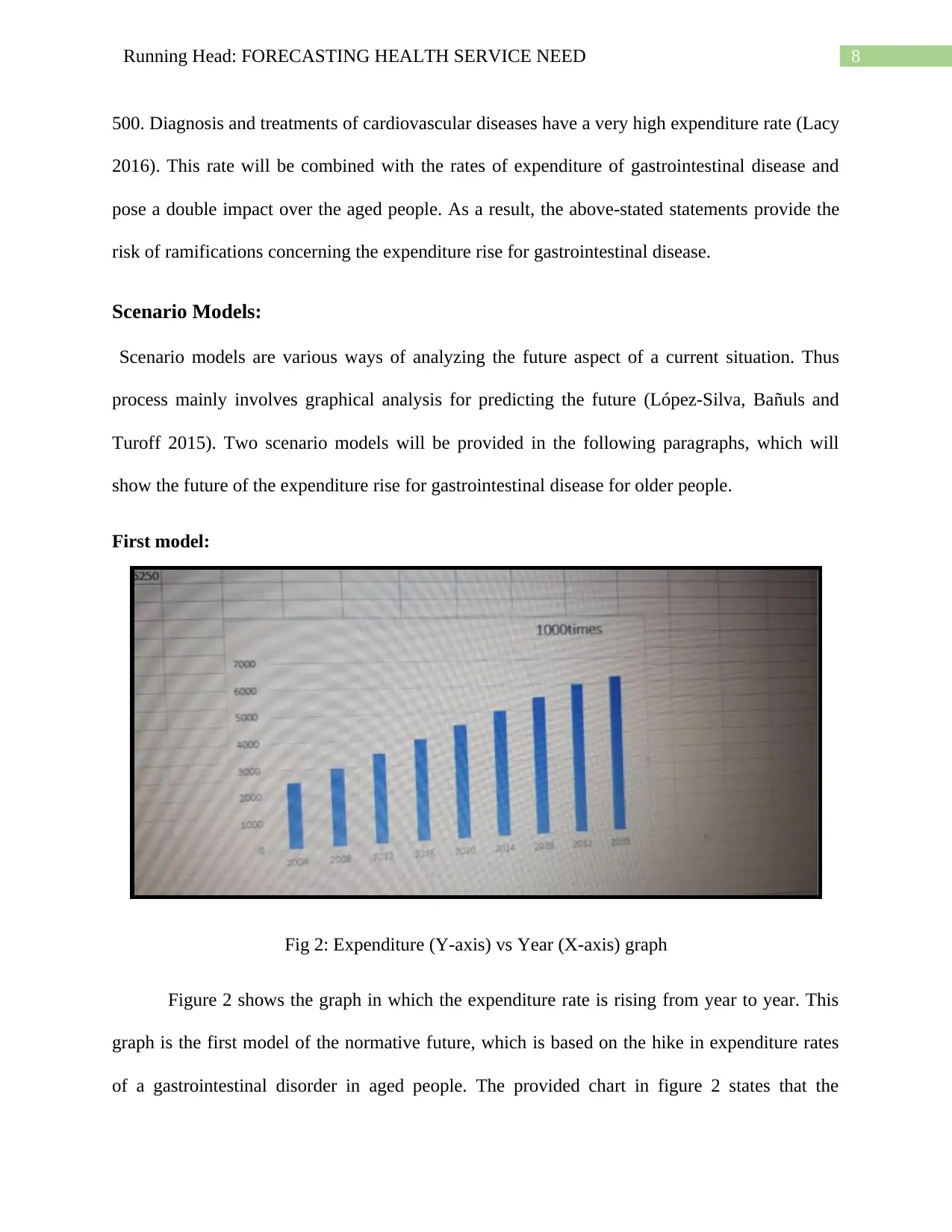
8Running Head: FORECASTING HEALTH SERVICE NEED
500. Diagnosis and treatments of cardiovascular diseases have a very high expenditure rate (Lacy
2016). This rate will be combined with the rates of expenditure of gastrointestinal disease and
pose a double impact over the aged people. As a result, the above-stated statements provide the
risk of ramifications concerning the expenditure rise for gastrointestinal disease.
Scenario Models:
Scenario models are various ways of analyzing the future aspect of a current situation. Thus
process mainly involves graphical analysis for predicting the future (López-Silva, Bañuls and
Turoff 2015). Two scenario models will be provided in the following paragraphs, which will
show the future of the expenditure rise for gastrointestinal disease for older people.
First model:
Fig 2: Expenditure (Y-axis) vs Year (X-axis) graph
Figure 2 shows the graph in which the expenditure rate is rising from year to year. This
graph is the first model of the normative future, which is based on the hike in expenditure rates
of a gastrointestinal disorder in aged people. The provided chart in figure 2 states that the
500. Diagnosis and treatments of cardiovascular diseases have a very high expenditure rate (Lacy
2016). This rate will be combined with the rates of expenditure of gastrointestinal disease and
pose a double impact over the aged people. As a result, the above-stated statements provide the
risk of ramifications concerning the expenditure rise for gastrointestinal disease.
Scenario Models:
Scenario models are various ways of analyzing the future aspect of a current situation. Thus
process mainly involves graphical analysis for predicting the future (López-Silva, Bañuls and
Turoff 2015). Two scenario models will be provided in the following paragraphs, which will
show the future of the expenditure rise for gastrointestinal disease for older people.
First model:
Fig 2: Expenditure (Y-axis) vs Year (X-axis) graph
Figure 2 shows the graph in which the expenditure rate is rising from year to year. This
graph is the first model of the normative future, which is based on the hike in expenditure rates
of a gastrointestinal disorder in aged people. The provided chart in figure 2 states that the
⊘ This is a preview!⊘
Do you want full access?
Subscribe today to unlock all pages.

Trusted by 1+ million students worldwide
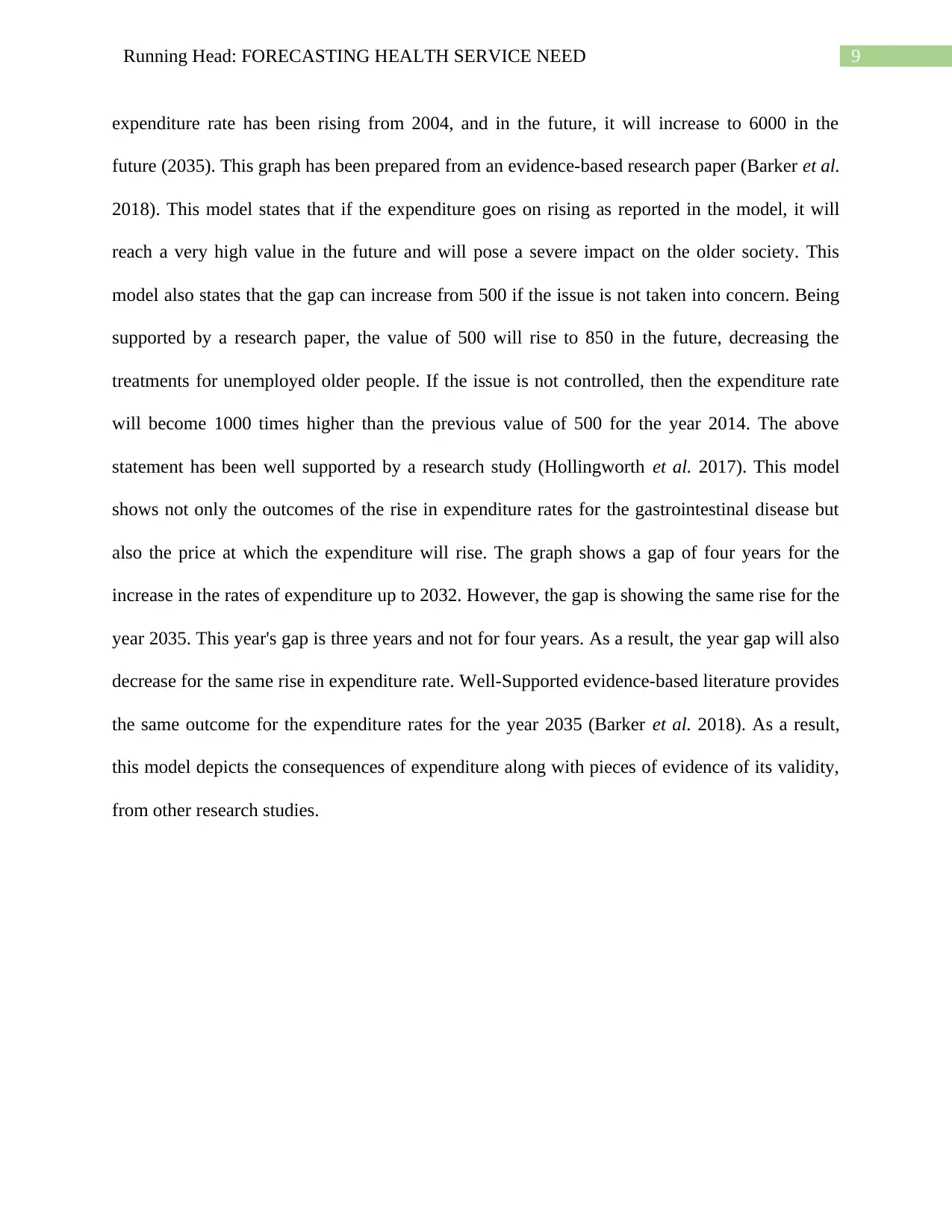
9Running Head: FORECASTING HEALTH SERVICE NEED
expenditure rate has been rising from 2004, and in the future, it will increase to 6000 in the
future (2035). This graph has been prepared from an evidence-based research paper (Barker et al.
2018). This model states that if the expenditure goes on rising as reported in the model, it will
reach a very high value in the future and will pose a severe impact on the older society. This
model also states that the gap can increase from 500 if the issue is not taken into concern. Being
supported by a research paper, the value of 500 will rise to 850 in the future, decreasing the
treatments for unemployed older people. If the issue is not controlled, then the expenditure rate
will become 1000 times higher than the previous value of 500 for the year 2014. The above
statement has been well supported by a research study (Hollingworth et al. 2017). This model
shows not only the outcomes of the rise in expenditure rates for the gastrointestinal disease but
also the price at which the expenditure will rise. The graph shows a gap of four years for the
increase in the rates of expenditure up to 2032. However, the gap is showing the same rise for the
year 2035. This year's gap is three years and not for four years. As a result, the year gap will also
decrease for the same rise in expenditure rate. Well-Supported evidence-based literature provides
the same outcome for the expenditure rates for the year 2035 (Barker et al. 2018). As a result,
this model depicts the consequences of expenditure along with pieces of evidence of its validity,
from other research studies.
expenditure rate has been rising from 2004, and in the future, it will increase to 6000 in the
future (2035). This graph has been prepared from an evidence-based research paper (Barker et al.
2018). This model states that if the expenditure goes on rising as reported in the model, it will
reach a very high value in the future and will pose a severe impact on the older society. This
model also states that the gap can increase from 500 if the issue is not taken into concern. Being
supported by a research paper, the value of 500 will rise to 850 in the future, decreasing the
treatments for unemployed older people. If the issue is not controlled, then the expenditure rate
will become 1000 times higher than the previous value of 500 for the year 2014. The above
statement has been well supported by a research study (Hollingworth et al. 2017). This model
shows not only the outcomes of the rise in expenditure rates for the gastrointestinal disease but
also the price at which the expenditure will rise. The graph shows a gap of four years for the
increase in the rates of expenditure up to 2032. However, the gap is showing the same rise for the
year 2035. This year's gap is three years and not for four years. As a result, the year gap will also
decrease for the same rise in expenditure rate. Well-Supported evidence-based literature provides
the same outcome for the expenditure rates for the year 2035 (Barker et al. 2018). As a result,
this model depicts the consequences of expenditure along with pieces of evidence of its validity,
from other research studies.
Paraphrase This Document
Need a fresh take? Get an instant paraphrase of this document with our AI Paraphraser
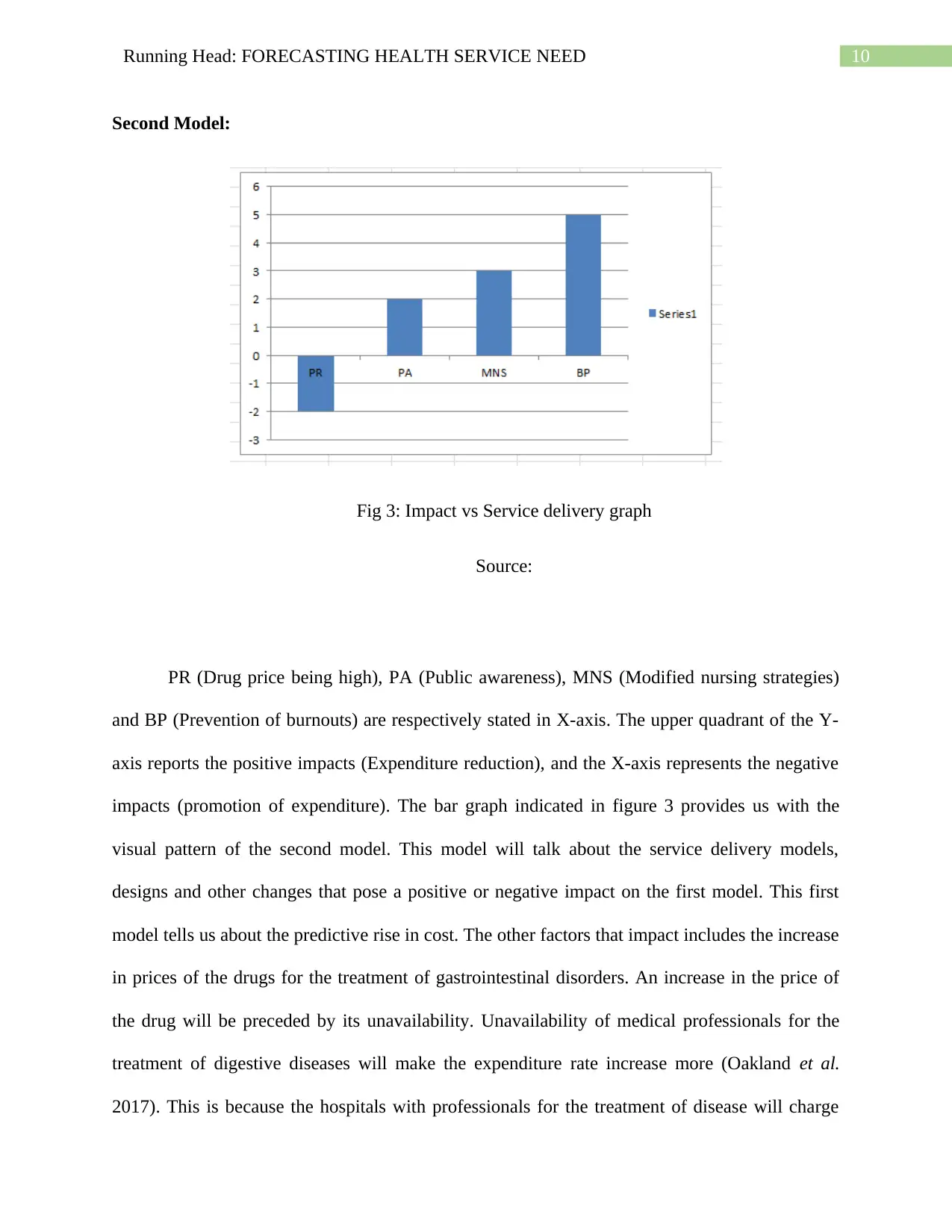
10Running Head: FORECASTING HEALTH SERVICE NEED
Second Model:
Fig 3: Impact vs Service delivery graph
Source:
PR (Drug price being high), PA (Public awareness), MNS (Modified nursing strategies)
and BP (Prevention of burnouts) are respectively stated in X-axis. The upper quadrant of the Y-
axis reports the positive impacts (Expenditure reduction), and the X-axis represents the negative
impacts (promotion of expenditure). The bar graph indicated in figure 3 provides us with the
visual pattern of the second model. This model will talk about the service delivery models,
designs and other changes that pose a positive or negative impact on the first model. This first
model tells us about the predictive rise in cost. The other factors that impact includes the increase
in prices of the drugs for the treatment of gastrointestinal disorders. An increase in the price of
the drug will be preceded by its unavailability. Unavailability of medical professionals for the
treatment of digestive diseases will make the expenditure rate increase more (Oakland et al.
2017). This is because the hospitals with professionals for the treatment of disease will charge
Second Model:
Fig 3: Impact vs Service delivery graph
Source:
PR (Drug price being high), PA (Public awareness), MNS (Modified nursing strategies)
and BP (Prevention of burnouts) are respectively stated in X-axis. The upper quadrant of the Y-
axis reports the positive impacts (Expenditure reduction), and the X-axis represents the negative
impacts (promotion of expenditure). The bar graph indicated in figure 3 provides us with the
visual pattern of the second model. This model will talk about the service delivery models,
designs and other changes that pose a positive or negative impact on the first model. This first
model tells us about the predictive rise in cost. The other factors that impact includes the increase
in prices of the drugs for the treatment of gastrointestinal disorders. An increase in the price of
the drug will be preceded by its unavailability. Unavailability of medical professionals for the
treatment of digestive diseases will make the expenditure rate increase more (Oakland et al.
2017). This is because the hospitals with professionals for the treatment of disease will charge

11Running Head: FORECASTING HEALTH SERVICE NEED
more for the treatment. Public awareness programs and modified nursing plans can make the
expenditure rate to decrease from the original value (Dodd 2017). The decrease will happen
because public awareness programs will be aware of the middle-aged people about the disease
expenditure and its consequences so that every individual gets a prior exposure to the current
situation. Modified nursing plans work in a cost-effective way to increase the effectiveness of the
treatment and reduce the time and cost of the procedure. Preventing burnouts will also have a
good impact on lowering the expenditure rate since this will ensure the prevention of additional
loss of the health service (Oakland et al. 2017). As a result, it can be stated that these designs or
factors will pose positive as well as the negative impact on the situation stated in the first model.
Another assumption of the number of deaths caused by gastrointestinal disorders in older
people will be discussed here. In figure 2, the bar graph states that a higher number of people are
meeting death due to digestive disorders every year. This factor is increasing continuously, and it
will grow to a very high value if not tackled properly.
Fig 2: Graphical representation for expected death rates for gastrointestinal disease in
older people
more for the treatment. Public awareness programs and modified nursing plans can make the
expenditure rate to decrease from the original value (Dodd 2017). The decrease will happen
because public awareness programs will be aware of the middle-aged people about the disease
expenditure and its consequences so that every individual gets a prior exposure to the current
situation. Modified nursing plans work in a cost-effective way to increase the effectiveness of the
treatment and reduce the time and cost of the procedure. Preventing burnouts will also have a
good impact on lowering the expenditure rate since this will ensure the prevention of additional
loss of the health service (Oakland et al. 2017). As a result, it can be stated that these designs or
factors will pose positive as well as the negative impact on the situation stated in the first model.
Another assumption of the number of deaths caused by gastrointestinal disorders in older
people will be discussed here. In figure 2, the bar graph states that a higher number of people are
meeting death due to digestive disorders every year. This factor is increasing continuously, and it
will grow to a very high value if not tackled properly.
Fig 2: Graphical representation for expected death rates for gastrointestinal disease in
older people
⊘ This is a preview!⊘
Do you want full access?
Subscribe today to unlock all pages.

Trusted by 1+ million students worldwide
1 out of 16
Related Documents
Your All-in-One AI-Powered Toolkit for Academic Success.
+13062052269
info@desklib.com
Available 24*7 on WhatsApp / Email
![[object Object]](/_next/static/media/star-bottom.7253800d.svg)
Unlock your academic potential
Copyright © 2020–2025 A2Z Services. All Rights Reserved. Developed and managed by ZUCOL.





